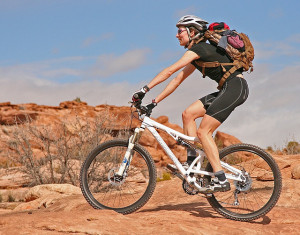 Utah ranks as the 8th most bike-friendly state this year, racking up points by increasing quantity of legislation and educational pushes to promote bicycling, measured by the League of American Bicyclists.
Utah ranks as the 8th most bike-friendly state this year, racking up points by increasing quantity of legislation and educational pushes to promote bicycling, measured by the League of American Bicyclists.
However, despite these regional strides forward, some motorists still harbor animosity towards cyclists on the roadways. The Ihatebicyclists.wordpress.com site, numerous anti-cyclists Facebook pages, and just searching the word “cyclist” on Twitter make these motorists’ resentment clear.
But why do these people disapprove so strongly of cycling on roadways, especially when the activity promises so many long-term benefits for a community? And how can you fight back?
Writer Tom Stafford suggested in a 2013 BBC.com article that “motorists hate cyclists because they think they offend the moral order.” He argued that motorists who follow the rules of the road–waiting their turn, signaling properly, following the speed limit, etc.–are offended that bikers are allowed to sometimes weave between cars, signal or pass differently, or go far below the speed limit. These motorists see cyclists, Stafford said, as problematic free riders, causing most people to react with high levels of anger and frustration. In sum, says Stafford:
“Deep within the human psyche, fostered there because it helps us co-ordinate with strangers … is an anger at people who break the rules, who take the benefits without contributing to the cost. And cyclists trigger this anger when they use the roads but don’t follow the same rules as cars.”
Never mind that it would be unwise and dangerous for cyclists to abide by the same rules. The inherent inequality, which some people interpret as unfair, causes an aggressive gut reaction.
But cyclists don’t have to coast by and accept the animosity directed towards them. Educating people about the long-term benefits of cycling, like the state of Utah has done, promotes positive motorist attitudes towards cyclists. Explaining the benefits of cycling opens the door for more people to start cycling regularly too.
Economic benefits
- Cycling saves big money; for example, in 2007, the constituents of Portland, Oregon, saved themselves and the city an estimated $2.6 billion by driving 2.9 billion fewer miles than average.
- Roadway wear and tear is less from bikes than from cars. Bikes also take up less parking and roadway space.
- Additionally, biking can increase consumer spending on local businesses, because riders tend to stop at shops along their commute.
Health benefits
- Countries with higher rates of cycling have lower obesity rates.
- When biking, your body burns over 500 calories per hour on average.
- Mental health benefits include lower stress and feelings of freedom and excitement. (Read more at the Oregon Bicycle Transportation Alliance.)
Environmental benefits
- Bicycling increases public transportation usage (cyclists use public transport for long distances), resulting in a smaller carbon footprint.
- An infrastructure changed to accommodate cyclists encourages compact, mixed-use development of land. This condenses the space of the city/county/etc., decreasing total transportation usage and costs and thus decreasing environmental impact.
- Almost half of all trips made (48%) are less than three miles, and almost a quarter (24%) are one mile or less. A three-mile commute on a bike generally takes less than 20 minutes, making it a feasible option for almost any commuter. (Read more at this Rails to Trails Conservancy publication.)
Photos courtesy of (top to bottom) Tom Brink, John Greenfield.
Sources:
http://www.businessinsider.com/what-americans-dont-get-about-cycling-2013-4
http://www.ceosforcities.org/files/PGD%20FINAL.pdf
https://btaoregon.org/2011/12/how-bicycling-connects-us-to-a-healthier-community-and-stronger-economy/
http://www.railstotrails.org/resources/documents/whatwedo/atfa/ATFA_20081020.pdf
